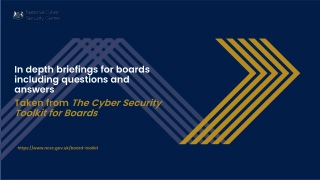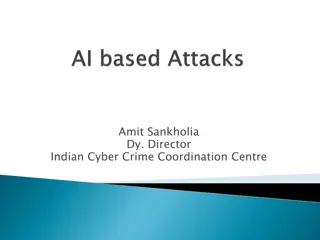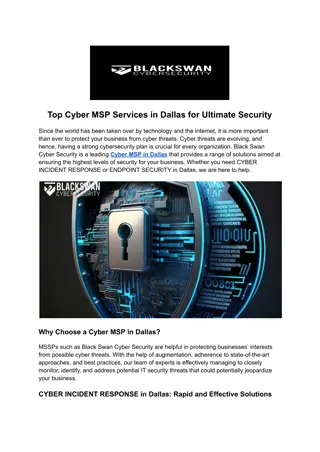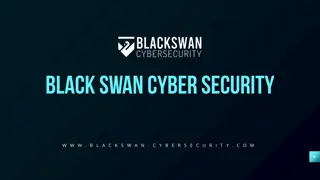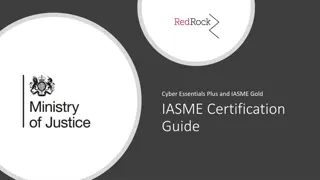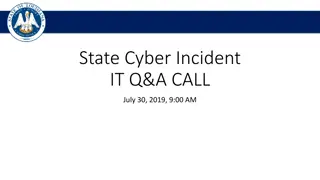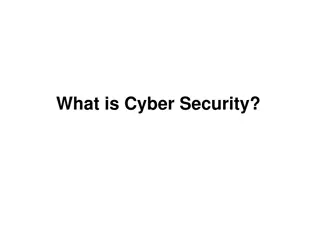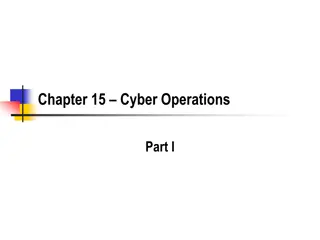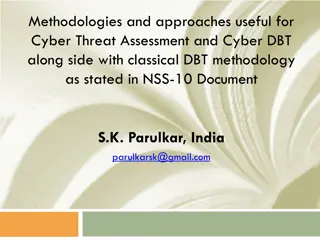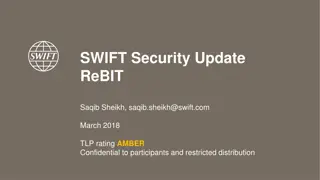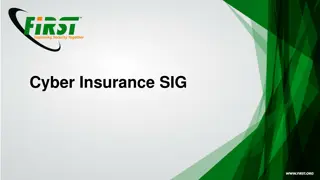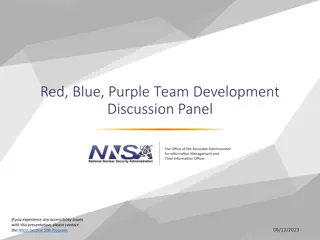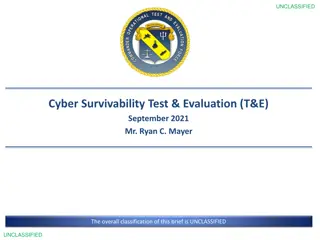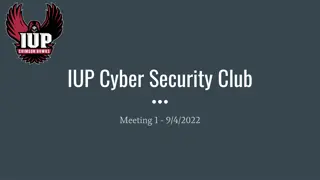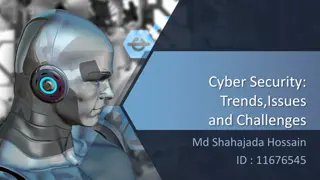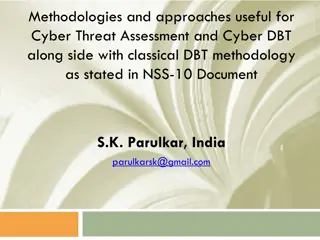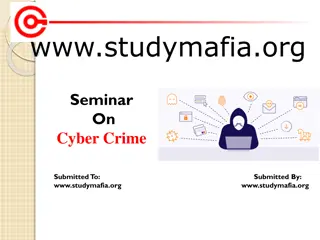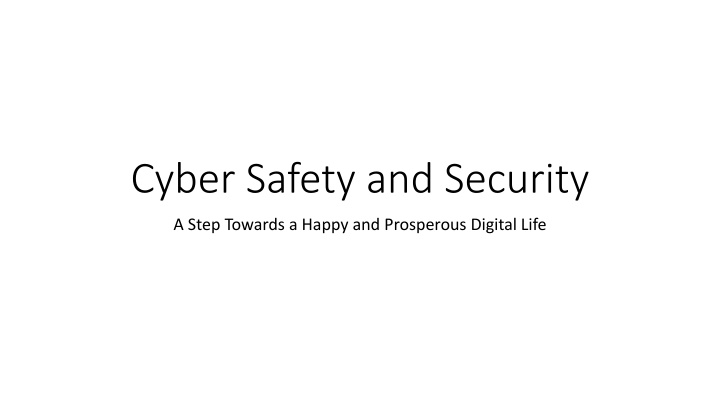
Digital Life and Personal Identity: Navigating Cyber Safety and Security
Enhance your digital life by understanding personal identity, cyber safety, and security measures. Explore the impact of online interactions, relationships, and screen time on mental and emotional well-being. Stay safe and secure in the digital world for a prosperous online existence.
Download Presentation

Please find below an Image/Link to download the presentation.
The content on the website is provided AS IS for your information and personal use only. It may not be sold, licensed, or shared on other websites without obtaining consent from the author. If you encounter any issues during the download, it is possible that the publisher has removed the file from their server.
You are allowed to download the files provided on this website for personal or commercial use, subject to the condition that they are used lawfully. All files are the property of their respective owners.
The content on the website is provided AS IS for your information and personal use only. It may not be sold, licensed, or shared on other websites without obtaining consent from the author.
E N D
Presentation Transcript
Cyber Safety and Security A Step Towards a Happy and Prosperous Digital Life
Personal Identity Sense of self and others Relationships Life Safety and Security Health Social and cultural belonging
Cyber Life = Our experiences+ identities+ interactions in the connected, online world Personal Identity Profiles/ Display Pictures Safety and Security Sense of self and others Likes/Filters/ Echo chambers Relationships Followers/ Communities Cyber Life Life Screen Time/ Addiction/ Posture Emotions Health Emotions
Profiles/ Display Pictures Personal Identity Safety and Security Likes/Filters/ Echo chambers Followers/ Communities Cyber Life Sense of self and others Relationships Life Screen Time/ Addiction/ Posture Emotions Emotions Health
Profiles/ Display Pictures Personal Identity Safety and Security Likes/Filters/ Echo chambers Followers/ Communities Cyber Life Sense of self and others Relationships Life Screen Time/ Addiction/ Posture Emotions Emotions Health
Profiles/ Display Pictures Personal Identity Safety and Security Likes/Filters/ Echo chambers Followers/ Communities Cyber Life Sense of self and others Relationships Life Screen Time/ Addiction/ Posture Emotions Emotions Health
Profiles/ Display Pictures Personal Identity Safety and Security Likes/Filters/ Echo chambers Followers/ Communities Cyber Life Sense of self and others Relationships Life Screen Time/ Addiction/ Posture Emotions Emotions Health
Profiles/ Display Pictures Personal Identity Safety and Security Likes/Filters/ Echo chambers Followers/ Communities Cyber Life Sense of self and others Relationships Life Social Screen Time/ Addiction/ Posture Engineering/ Ai Scams Emotions Health
Profiles/ Display Pictures Personal Identity Safety and Security Likes/Filters/ Echo chambers Followers/ Communities Cyber Life Sense of self and others Relationships Life Screen Time/ Addiction/ Posture Emotions Emotions Health
Personal Identity in Cyber World Username /Password Biometrics OTP Social media profile Photos/Videos Location
Personal Identity in Cyber World Username /Password Biometrics OTP Social media profile Photos/Videos Location
Personal Identity in Cyber World Username /Password Biometrics Identity Theft OTP Social media profile Photos/Videos Location
Identity Theft Financial Loss Bank fraud, unauthorized purchases, loan defaults in your name. Legal Trouble Criminal records or legal actions for things you didn t do. Reputation Damage Harmful posts or messages sent from hacked accounts. Loss of Access Locked out of your own accounts, emails, or even devices. Emotional Stress Anxiety, fear, and trust issues online and offline.
Identity Theft Protect Financial Data Use strong, unique passwords for banking apps. Enable two-factor authentication (2FA). Secure Personal Info Never share Aadhar, PAN, or OTPs via phone or chat. Avoid uploading sensitive documents online. Monitor Digital Identity Regularly check your social media, email, and bank activity for suspicious behaviour. Use Security Tools Install antivirus, keep devices updated, and avoid using public Wi-Fi for sensitive transactions. Stay Aware & Educated Think before you click. Be alert to phishing, fake profiles, and too-good-to-be-true offers.
Relationships in Cyber World Type Examples Social media connections, gaming pals Digital Friendships Online dating, digital love Virtual Intimacy LinkedIn contacts, online mentors Professional Bonds Influencers, YouTubers, Celebs Parasocial Relationships Reddit, forums, alternate avatars Anonymous Connections
Relationships in Cyber World Be Mindful Surveillance & Stalking Followers can silently track your activities, locations, routines leading to digital stalking or even offline risk. Echo Chambers & Misinformation Communities can reinforce false beliefs or bias, spreading fake news. Cyberbullying & Trolling Negative comments, or public shaming Identity Cloning & Impersonation Public profiles with lots of followers are often cloned to create fake accounts. Unknowingly Sharing Personal Information Oversharing in friendly groups can expose passwords, family details, or habits.
Prevention is better than cure Prevention is better than cure Search your name periodically to check for fakes. Ask friends to report impersonators. Report cloned accounts quickly platforms take them down faster with multiple reports. Use block, mute, and report features aggressively. Maintain support networks talk about it with someone you trust. Document incidents (screenshots) in case legal action is needed. Encourage positive digital behaviour in your circles. Avoid sharing family schedules, birthdays, passwords, routines publicly. Keep private groups truly private audit who s inside.
Prevention is better than Cure Prevention is better than Cure Follow diverse sources for news and opinions. Don't accept friend/follow requests from strangers. Never share OTP, banking info, or passwords. When available, enable 2-factor authentication (2FA) for important transactions Turn off location sharing on social media posts. Regularly review privacy settings on apps. Avoid posting real-time updates about your whereabouts. Use nickname, usernames if possible, and restrict story views to close friends.
Health in Cyber World Mental Health Awareness Access to online therapy, support groups, mindfulness apps Physical Fitness Tools Fitness trackers, yoga sessions, health coaching via apps Health Education Reliable information, webinars, awareness about diseases Community & Connection Support networks for chronic illness, disabilities, etc.
Beware!! Researches state that : Rise in Anxiety & Depression: Use of social media is associated with increased risk of depression, anxiety, and psychological distress. Source: Stanford Law Social Media Addiction Report ? Loneliness & Empathy Loss: Excessive social networking leads to feelings of isolation, reduced face-to-face interaction, and lower empathy. Source: Cureus Systematic Review on Adolescents & Mental Health Like-Based Self-Worth: Users self-esteem is influenced by online feedback; lack of likes causes emotional stress and self-doubt
Be Mindful Set daily screen limits with apps like Digital Wellbeing (Android) or Screen Time (iOS). Schedule No-Social zones: no phones at meals, bedtime, or first thing in the morning. Encourage offline hobbies (sports, arts, journaling) to reduce reliance on digital gratification. Promote mindfulness practices meditation, breathing exercises, journaling thoughts. Prioritize in-person connections: plan meetups, family time, group activities. Talk openly about mental health and normalize seeking professional help.
Physical Health concerns in Cyber World Tech Neck Head bent forward, hunched shoulders while looking down at phone Risk: Neck pain, headaches, spinal strain Laptop Slouch Leaning forward toward screen Risk: Lower back pain, poor digestion, fatigue Phone Cradle Holding phone between ear and shoulder Risk: Neck and shoulder stiffness Wrist Strain / Text Claw Excessive typing or scrolling Risk: Tendonitis, numbness, finger cramps
Physical Health concerns in Cyber World Sit back with your spine supported Screen at eye level Prioritize ergonomics Take a break every 30 45 minutes Do quick neck, wrist, and shoulder stretches Practice "20-20-20 Rule" (every 20 mins, look 20 feet away for 20 seconds)
Emotions Social Engineering and AI scams Emotion Example Action Fear "Your bank account will be blocked! You are under DIGITAL ARREST People panic and share sensitive data without verifying. Greed "You ve won 1 lakh click to claim!" Too-good-to-be-true offers prompt impulsive clicks. Trust Fake emails or DMs pretending to be from a friend, boss, or organization. AI-generated deepfakes or cloned voices make it more convincing. People panic and share sensitive data without verifying.
Emotions Social Engineering and AI scams Emotion Example Action Urgency Act now or Lose your OTP access!" Users are pushed to act emotionally rather than rationally. Loneliness & Likeability I am there for you . Romance scams or phishing via dating apps tap into emotional vulnerability. People share personal info due to emotional bonding with strangers. Sympathy This child needs your help . AI- generated charity scams showing emotional appeals or fake victim videos. Viewers donate or share data out of sympathy.
Emotions Practice Cyber Resilience Think "Is this message meant to provoke a quick emotional response like fear or urgency? Pause Take a deep breath Verify I have all the right in the world to check a claim
Cyber Scams that feed on your Emotions Scam Name Emotion Targeted Tactic Used Fake calls from "cyber crime officers" alleging illegal activity to extort money. Digital Arrest Scam Fear & Authority Fake online relationships to emotionally manipulate and steal money or data. Romance Scam Loneliness & Love You won 1 crore! messages prompting payment of a "processing fee." Lottery/Fake Prize Scam Greed & Excitement Your friend is in trouble send money now! impersonating loved ones. Emergency Scam Panic & Concern
Cyber Scams that feed on your Emotions Scam Name Emotion Targeted Tactic Used Fake causes post-disaster to emotionally exploit people into donating. Charity Scam Guilt & Empathy Too-good-to-be-true jobs requiring upfront payment or personal data. Job Offer Scam Hope & Desperation AI-generated explicit videos/images used for extortion. Deepfake Blackmail Shame & Fear "Urgent help" messages from hacked accounts to emotionally convince contacts. Social Media Account Hijack Trust & Urgency
Stay Updated - Read Newspapers and Check your bank websites for regular updates on Cyber Safety and security. You can also visit : https://www.infosecawareness.in https://i4c.mha.gov.in/
Case Study can lead to Biometric Identity Theft Preventive Measures: Limit Hand Visibility in Photos: Avoid sharing high-resolution photos where fingerprints are clearly visible. Enhance Biometric Security: Use multi-factor authentication that combines fingerprints with other methods like passwords or facial recognition. Stay Updated: Be aware of current threats and protect your privacy settings on social media to limit who can view your content. Source: https://www.news18.com/tech/do-you-post-personal-photos-online-heres-how-your-fingerprints-can-be-stolen-9033343.html
Case study It can lead to an AI driven Scam Precautions to Minimize Risks: Privacy Settings: Ensure strict privacy controls on social media accounts to limit access to shared content. Selective Sharing: Avoid sharing personal details such as full names, birth dates, or location tags. Awareness of AI Capabilities: Understand that AI can rapidly analyze and use publicly available data, making it crucial to think before sharing. Source: https://edition.cnn.com/2024/09/25/health/sharenting-children-social-media-dangers-wellness/index.html
Case study Preventive Measures for Juice Jacking: Use Personal Charger or portable power banks 1. 2. Avoid Public USB Ports 3. Charge Through Wall Outlets 4. Disable Data Transfer: Set your device to Charge Only mode when plugged in. 5. Stay Updated: Keep your device's software up-to- date to safeguard against potential vulnerabilities.
Personal Protection Use strong passwords: At least 8 characters, include letters, numbers & symbols. Enable 2FA (Two-Factor Authentication) on all major accounts. Avoid sharing personal info like address, school, or routine publicly. Log out from public/shared devices.
Safe Browsing Access only HTTPS websites ( icon in URL bar). Be cautious with pop-ups and suspicious links. Don t download pirated software or unknown files. Install ad blockers to prevent malvertising.
Social Media Safety Keep profiles private; limit visibility to friends only. Don t accept friend requests from strangers. Think before you post: Would I say this in public? Turn off location sharing unless absolutely needed.
Communication Hygiene Don t share passwords or OTPs over chats. Report suspicious emails or messages (phishing). Verify identities before clicking unknown links or attachments. Watch for scam calls and fake job offers.
Report In case of a fraud: https://cybercrime.gov.in/webform/crmcondi.aspx Call 1930 Cyber Crime Helpline Preserve evidence Contact local police station in case of an emergency
The virtual world mirrors our real world it s a digital extension of who we are. "Cyber safety and security isn t just about technology it s about understanding ourselves and securing our cyber life."


